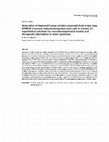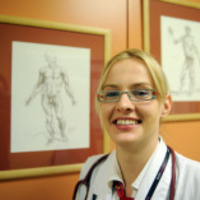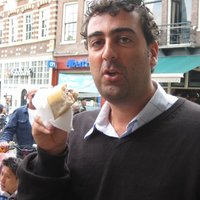Papers by E. Sacide Çağlayan

Cell biology international, Jan 24, 2015
Pluripotent stem cells (PSCs) have the capacity to differentiate into any cell type of the body. ... more Pluripotent stem cells (PSCs) have the capacity to differentiate into any cell type of the body. Therefore, induced pluripotent stem cells (iPSCs) are seen as promising solution for patient-specific cell therapies. However, the safety is major issue for in vitro methods, that are used in induction of pluripotency and also in differentiation of PSCs toward specific cell types. In pioneer studies of iPSC generation, the role of c-Myc has been highlighted as a possible master regulator of pluripotency, but direct c-Myc overexpression is known to prompt drawbacks, especially in human cells. In recent studies, the role of non-protein coding RNA molecules such as microRNAs (miRNAs) have been shown in enhanced reprogramming efficiency. In addition, new reprogramming methods have been ultimately improved by adding miRNAs, in the absence of previous factors. Cross interaction between miRNAs and c-Myc has been also found in differentiation of iPSCs, as well as in reprogramming and self-renewi...
Cell Biology International, 2016
† This article has been accepted for publication and undergone full peer review but has not been ... more † This article has been accepted for publication and undergone full peer review but has not been through the copyediting, typesetting, pagination and proofreading process, which may lead to differences between this version and the Version of Record. Please cite this article as

Dual-specificity thyrosine phosphorylation-regulated kinase 1A (DYRK1A) is a strong therapeutic t... more Dual-specificity thyrosine phosphorylation-regulated kinase 1A (DYRK1A) is a strong therapeutic target to ameliorate cognitive
functions of Down Syndrome (DS). Genetic normalization of Dyrk1a is sufficient to normalize early cortical developmental
phenotypes in DS mouse models. Gyrencephalic human neocortical development is more complex than that in lissencephalic
mice; hence, cerebral organoids (COs) can be used to model early neurodevelopmental defects of DS. Single copy DYRK1A
knockoutCOs (scDYRK1AKO-COs) can be generated frommanipulated DS derived (DS-) induced pluripotent stem cells (iPSCs)
and genetic normalization of DYRK1A is expected to result in corrected neurodevelopmental phenotypes that can be reminiscent
of normal COs. DYRK1A knock-in (DYRK1AKI) COs can be derived after genetic manipulations of normal iPSCs and would be
valuable to evaluate impaired neocortical development as can be seen inDS-COs.DYRK1Amutations cause severe humanprimary
microcephaly; hence, dose optimization studies of DYRK1A inhibitors will be critical for prenatal therapeutic applications in DS.
Several doses of DYRK1A inhibitors can be tested in the neurodevelopment process of DS-COs and DS-scDYRK1AKO-COs
would be used as optimummodels for evaluating phenotypic ameliorations.Overdose drug exposure inDS-COs can be explained
by similar defects present in DS-baDYRK1AKO-COs and DYRK1AKO-COs. There are several limitations in the current CO
technology, which can be reduced by the generation of vascularized brain-like organoids giving opportunities tomimic late-stage
corticogenesis and complete hippocampal development. In the future, improved DS-DYRK1AKO-COs can be efficient in studies
that aim to generate efficiently transplantable and implantable neurons for tissue regeneration alternatives in DS individuals.

Pluripotent stem cells (PSCs) have the capacity to differentiate into any cell type of the body. ... more Pluripotent stem cells (PSCs) have the capacity to differentiate into any cell type of the body. Therefore, induced pluripotent stem cells (iPSCs) are seen as promising solution for patient-specific cell therapies. However, the safety is major issue for in vitro methods, that are used in induction of pluripotency and also in differentiation of PSCs toward specific cell types. In pioneer studies of iPSC generation, the role of c-Myc has been highlighted as a possible master regulator of pluripotency, but direct c-Myc overexpression is known to prompt drawbacks, especially in human cells. In recent studies, the role of non-protein coding RNA molecules such as microRNAs (miRNAs) have been shown in enhanced reprogramming efficiency. In addition, new reprogramming methods have been ultimately improved by adding miRNAs, in the absence of previous factors. Cross interaction between miRNAs and c-Myc has been also found in differentiation of iPSCs, as well as in reprogramming and self-renewing the pluripotent state. Thence, miRNAs are promising solution for efficiency and safety of iPSC derivation and differentiation methods. The purpose of the present review is to evaluate interaction mechanisms of miRNAs with c-Myc and in iPSC technology.









Uploads
Papers by E. Sacide Çağlayan
functions of Down Syndrome (DS). Genetic normalization of Dyrk1a is sufficient to normalize early cortical developmental
phenotypes in DS mouse models. Gyrencephalic human neocortical development is more complex than that in lissencephalic
mice; hence, cerebral organoids (COs) can be used to model early neurodevelopmental defects of DS. Single copy DYRK1A
knockoutCOs (scDYRK1AKO-COs) can be generated frommanipulated DS derived (DS-) induced pluripotent stem cells (iPSCs)
and genetic normalization of DYRK1A is expected to result in corrected neurodevelopmental phenotypes that can be reminiscent
of normal COs. DYRK1A knock-in (DYRK1AKI) COs can be derived after genetic manipulations of normal iPSCs and would be
valuable to evaluate impaired neocortical development as can be seen inDS-COs.DYRK1Amutations cause severe humanprimary
microcephaly; hence, dose optimization studies of DYRK1A inhibitors will be critical for prenatal therapeutic applications in DS.
Several doses of DYRK1A inhibitors can be tested in the neurodevelopment process of DS-COs and DS-scDYRK1AKO-COs
would be used as optimummodels for evaluating phenotypic ameliorations.Overdose drug exposure inDS-COs can be explained
by similar defects present in DS-baDYRK1AKO-COs and DYRK1AKO-COs. There are several limitations in the current CO
technology, which can be reduced by the generation of vascularized brain-like organoids giving opportunities tomimic late-stage
corticogenesis and complete hippocampal development. In the future, improved DS-DYRK1AKO-COs can be efficient in studies
that aim to generate efficiently transplantable and implantable neurons for tissue regeneration alternatives in DS individuals.
functions of Down Syndrome (DS). Genetic normalization of Dyrk1a is sufficient to normalize early cortical developmental
phenotypes in DS mouse models. Gyrencephalic human neocortical development is more complex than that in lissencephalic
mice; hence, cerebral organoids (COs) can be used to model early neurodevelopmental defects of DS. Single copy DYRK1A
knockoutCOs (scDYRK1AKO-COs) can be generated frommanipulated DS derived (DS-) induced pluripotent stem cells (iPSCs)
and genetic normalization of DYRK1A is expected to result in corrected neurodevelopmental phenotypes that can be reminiscent
of normal COs. DYRK1A knock-in (DYRK1AKI) COs can be derived after genetic manipulations of normal iPSCs and would be
valuable to evaluate impaired neocortical development as can be seen inDS-COs.DYRK1Amutations cause severe humanprimary
microcephaly; hence, dose optimization studies of DYRK1A inhibitors will be critical for prenatal therapeutic applications in DS.
Several doses of DYRK1A inhibitors can be tested in the neurodevelopment process of DS-COs and DS-scDYRK1AKO-COs
would be used as optimummodels for evaluating phenotypic ameliorations.Overdose drug exposure inDS-COs can be explained
by similar defects present in DS-baDYRK1AKO-COs and DYRK1AKO-COs. There are several limitations in the current CO
technology, which can be reduced by the generation of vascularized brain-like organoids giving opportunities tomimic late-stage
corticogenesis and complete hippocampal development. In the future, improved DS-DYRK1AKO-COs can be efficient in studies
that aim to generate efficiently transplantable and implantable neurons for tissue regeneration alternatives in DS individuals.